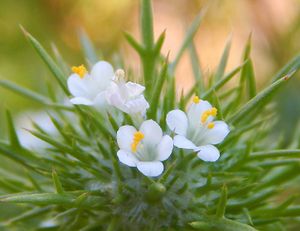Difference between revisions of "Navarretia intertexta"
From Puget Prairie Plants
(Tag: VisualEditor) |
m (→Taxonomy) (Tag: VisualEditor) |
||
| Line 6: | Line 6: | ||
==Taxonomy== | ==Taxonomy== | ||
{{Taxobox | {{Taxobox | ||
| − | | image = | + | | image =NAVINT1.jpg |
| − | | image_caption = | + | | image_caption =Photo by Roger T. George, 2016. Also featured on Main Page. |
| name = ''''' Navarretia intertexta''''' | | name = ''''' Navarretia intertexta''''' | ||
| regnum = [[Plant]]ae | | regnum = [[Plant]]ae | ||
| Line 48: | Line 48: | ||
<gallery> | <gallery> | ||
File:NAVINT4.jpg|Seedlings sprouting up, courtesy of CNLM | File:NAVINT4.jpg|Seedlings sprouting up, courtesy of CNLM | ||
| + | File:NAVINT2.jpg|Photo by Roger T. George, 2016. | ||
| + | File:NAVINT3.jpg|Photo by Roger T. George, 2016. | ||
</gallery> | </gallery> | ||
==References== | ==References== | ||
<references /> | <references /> | ||
Revision as of 10:10, 23 January 2021
- Latin Name: Navarretia intertexta
- Family: Polemoniaceae
- Common Names: needleleaf navarretia, needleleaf pincushion-plant
- Synonyms/Misapplications: Navarretia minima Nutt. var. intertexta
- CODON: NAVINT
Contents
Taxonomy
| Navarretia intertexta | |
|---|---|

| |
| Photo by Roger T. George, 2016. Also featured on Main Page. | |
| Scientific classification | |
| Kingdom: | Plantae |
| Subkingdom: | Tracheobionta |
| Phylum: | Spermatophyta |
| Subphylum: | Magnoliophyta |
| Class: | Magnoliopsida |
| Subclass: | Asteranae |
| Order: | Ericales |
| Family: | Polemoniaceae |
| Genus: | Navarretia Ruiz & Pav. |
| Species: | Navarretia intertexta (Benth.) Hook. |
Description
Annual taprooted herb.
Leaves 1-2 times pinnate, needle-like at tips, lobes spreading. Often white-hairy at leaf base.
Inflorescence consisting of terminal bracteate sessile flower heads, conspicuously hairy, bracts also forked, needle-like, lobes spreading, often exceeding corollas. Corollas white, 5 egg-shaped lobes, stamen exserted, exceeding corolla.
Fruits are 2-chambered capsules, each chamber containing 3-5 seeds, which become sticky when moistened.[1][2]
Bloom Period
June-August[3]
Distribution
Southwest BC to California, on both sides of Cascades, east to western Montana and Idaho, Utah, and Arizona, Rocky Mountains, and Great Basin.[4]
Habitat
Moist to moderately dry sites up to mid elevations in mountains.[4]
Photo Gallery
References
- ↑ Klinkenberg, Brian. (Editor) 2020. E-Flora BC: Electronic Atlas of the Plants of British Columbia [eflora.bc.ca]. Lab for Advanced Spatial Analysis, Department of Geography, University of British Columbia, Vancouver. [Accessed:2020-05-09]
- ↑ Leigh A. Johnson 2013, Navarretia intertexta, in Jepson Flora Project (eds.) Jepson eFlora, Revision 1, /eflora/eflora_display.php?tid=34455, accessed on June 04, 2020.
- ↑ WTU Herbarium, Burke Museum, & University of Washington. Retrieved from https://biology.burke.washington.edu/herbarium/imagecollection/taxon.php?Taxon=Navarretia%20intertexta
- ↑ 4.0 4.1 Hitchcock, C. L., Cronquist, A., Giblin, D., & Legler, B. et al. (2018). Flora of the Pacific Northwest: an illustrated manual. Seattle: University of Washington Press.



